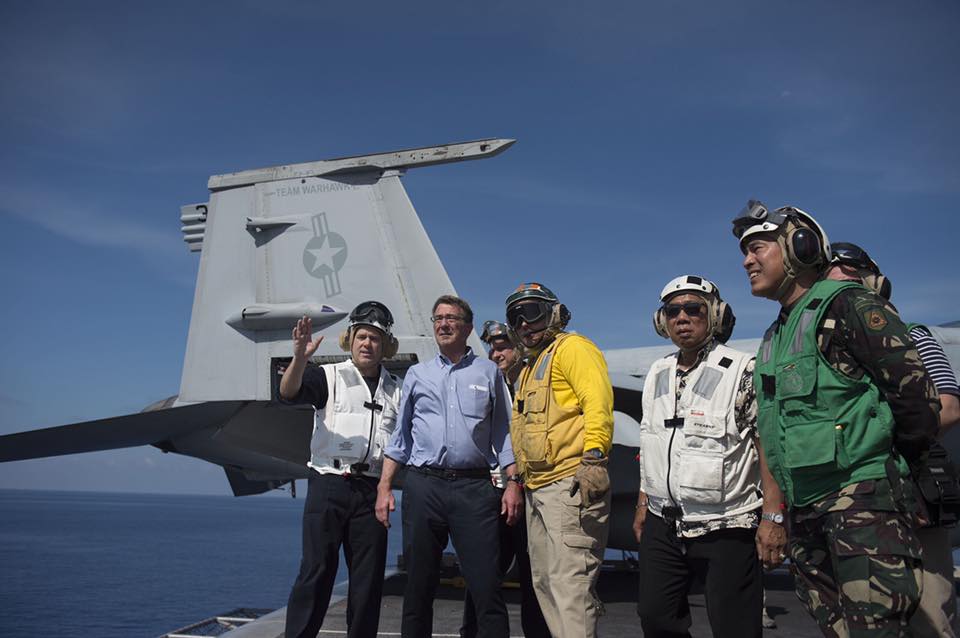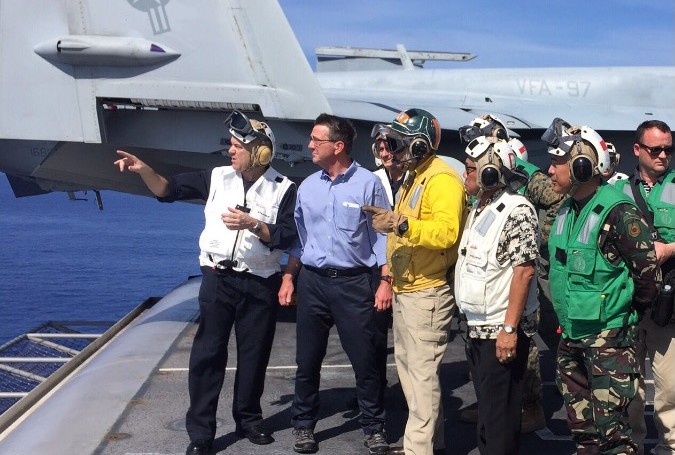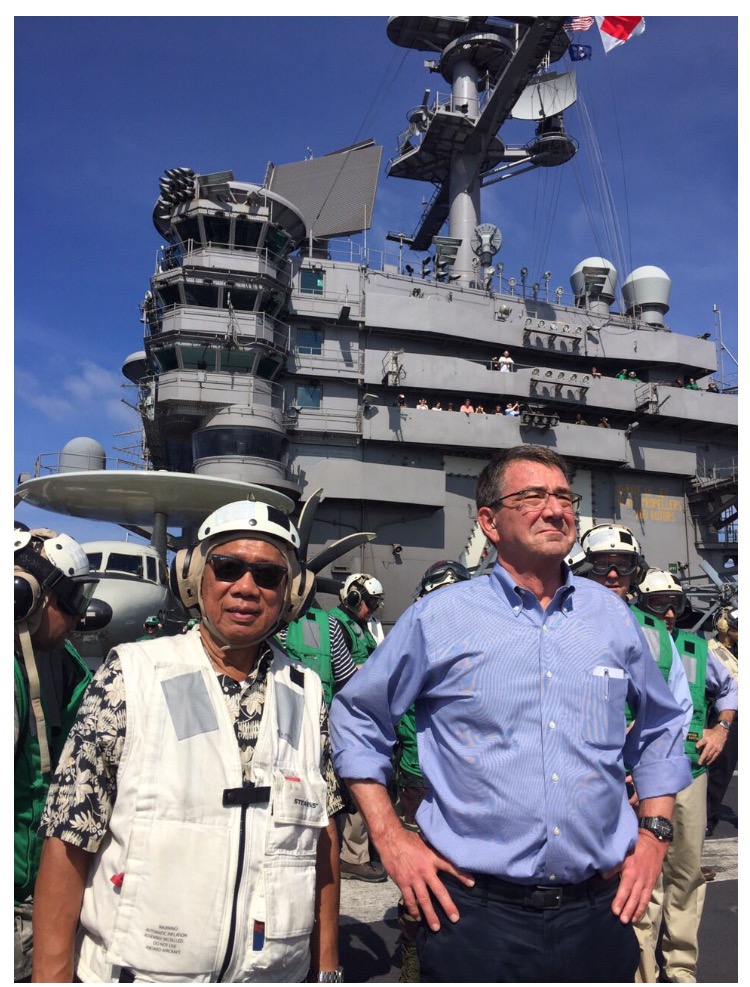US shows power in Asia

US Secretary of Defense Ashton Carter (second from left), Philippine Defense Sec. Voltaire Gazmin (second from right) and Armed Forces of the Philippines chief Gen. Hernando Iriberri visit the USS John Stennis. PHOTO FROM US DEPARTMENT OF DEFENSE’S FACEBOOK PAGE
ABOARD THE USS JOHN C. STENNIS—For the second time in five months, Defense Secretary Ashton Carter landed aboard a US aircraft carrier in the bitterly contested South China Sea, sending a deliberate message to China on American power in the region.
READ: LOOK: US and PH defense chiefs visit South China Sea
With a key Asia-Pacific ally at his side on the USS John C. Stennis on Friday, Carter said the only reason America’s presence in the region came up as an issue was because of China’s behavior in the South China Sea over the past year.
“That’s a question of Chinese behavior,” Carter told reporters as he and Philippine Defense Secretary Voltaire Gazmin watched US Navy F/A 18 “Hornet” fighter jets launch into the vivid blue skies, about 126 kilometers west of the main Philippine island of Luzon.
“What’s new is not an American carrier in this region. What’s new is the context of tension [that] exists, which we want to reduce,” Carter said.
China late on Thursday reacted defiantly to Carter’s announcement of joint US-Philippine patrols in the South China Sea and the rotation of more US troops with combat aircraft and equipment to the Philippines under a new security agreement.
“US-Philippine joint patrols in the South China Sea promote regional militarization and undermine regional peace and stability,” the Chinese defense ministry said in a statement.
“The Chinese military will pay very close attention to related developments, and firmly safeguard China’s territorial sovereignty and maritime rights and interests,” it said.
Sweeping claims
China claims nearly the whole of the 3.5-million-square-kilometer South China Sea, even waters close to the shores of its Southeast Asian neighbors, and has over the past year built artificial islands in the Spratly archipelago to assert what it insists is its “undisputed sovereignty” over territory in the sea also claimed by the Philippines, Brunei, Malaysia, Vietnam and Taiwan.
The Chinese defense ministry’s statement also referenced China’s longstanding opposition to US military alliances in the region. It regards those as a form of unwelcome interference that stymies its desired status as the preeminent military power in the Asia-Pacific region.
“Strengthening the US-Philippine military alliance … is a sign of a Cold War mentality that is unbeneficial to peace and stability in the South China Sea,” it said.
On Friday, Carter emphasized the United States would back up the Philippines and other allies in the region.
READ: US vows support for allies in Asia
“At a time of change in this dynamic region, and democratic transitions in the Philippines and the United States, we will continue to stand shoulder to shoulder,” Carter said at the closing ceremony for Balikatan 2016, the annual war games between US and Philippine troops, at Camp Aguinaldo, the Philippine military’s headquarters in Quezon City.
“We will continue to stand up for our safety and freedoms, for those of our friends and allies, and for the values, principles and rules-based order that has benefited so many for so long,” he said.
Carter’s visit aboard the Stennis underscores persistent complaints from the United States and its allies in the region about China’s military buildup in the South China Sea.
Later in the massive gray ship’s hangar bay, Carter said his message in making the trip was that the United States “intends to continue to play a role in keeping peace and stability in this region.”
Rear Adm. Ronald Boxall, the commander of Carrier Strike Group 3, told reporters that the Stennis and the ships in the carrier’s strike group “regularly have a (Chinese) ship or two operating with us or near us.”
So far, he said, the Chinese vessels have been operating very professionally.
“We’ve been very pleased with the interactions we’ve had,” he said. “They are operating where they think they should, we’re operating where we think we should. They generally have professional discussions over the bridge about where we are.”

Defense officials of the Philippines and the United States watch the operations at the USS John Stennis. PHOTO FROM THE PHILIPPINE DEPARTMENT OF NATIONAL DEFENSE
Flight to the carrier
Accompanied by Gazmin, Armed Forces of the Philippines Chief of Staff Gen. Hernando Iriberri and Defense Undersecretary Emmanuel Bautista, Carter rode to Villamor Air Base in Pasay City after the Balikatan closing ceremony and took a Boeing C-17 Globemaster aircraft for a flight to Palawan.
READ: US defense chief visits US warship in South China Sea
From Palawan, the closest Philippine landmass to the Spratly archipelago, they took a Bell Boeing V-22 Osprey military helicopter for a short flight to the Stennis, which was in Philippine-claimed waters.
Under a blazing sun, as the heat index pushed past 37 degrees Celsius, Carter and the Philippine officials landed on the Stennis.
Carter spent about two hours on the ship, watching a number of fighter jets shoot into the sky off the flight deck, do circles around the Stennis and then land again, roaring to a stop as their tailhook caught the arresting wire.
He later spoke to several hundred sailors in the hangar bay, including one who asked why the United States allows China to participate in the large annual military exercise in the Asia-Pacific region.
Carter said the United States wanted to work together with China, and added that Beijing should not isolate itself.
Not aimed at anyone
The United States insists that the increasing American presence in the South China Sea and the broader Asia-Pacific region is meant to show support for allies and is not aimed at any one nation.
But the US military presence also reinforces Carter’s assertion that America will continue to fly and sail throughout the region, despite China’s claims of sovereignty over the vast South China Sea.
China’s foreign ministry statement on Thursday said “military exchanges by relevant countries should not target third parties, much less support a few countries in challenging China’s sovereignty and security, inciting regional contradictions and sabotaging regional peace and stability.”

And on Friday, Chinese foreign ministry spokesperson Lu Kang said that, “Before the US returned to the Asia-Pacific region, relevant countries had sought to control the disputes and handle the conflicts through friendly negotiations, despite the disputes having existed for over four decades.”
He told reporters during a press conference that if the United States wanted a peaceful solution to disputes, “I hope it can practice what it has preached, and that their actions can really help to peacefully solve the disputes.”
The Philippines has challenged China’s sweeping claims in the South China Sea at the United Nations Permanent Court of Arbitration.
China has refused to take part in the arbitration, and said it would not recognize any ruling by the court.
The tribunal has proceeded to hear the case, though, and is expected to hand down a ruling in coming weeks.
The United States has said it does not take a position on the territorial disputes, but wants them settled legally.

Philippine Secretary of Defense Voltaire Gazmin and US Secretary of Defense Ashton Carter aboard the USS John Stennis. PHOTO FROM THE PHILIPPINE DEPARTMENT OF DEFENSE
Message of solidarity
But Carter’s visit to the Philippines last week, and Gazmin’s presence on the Stennis sent a more pointed message of solidarity.
The visit to the Stennis came a day after Carter announced new military aid to the Philippines that spurred protests from China.
This was the second time that Carter had flown onto a carrier while it was embarked in the South China Sea. Last November, he was on the USS Theodore Roosevelt as it sailed northwest of Borneo.
That visit came just a week after a US Navy destroyer, the USS Lassen, challenged China’s claim to a 21-km territorial limit around Zamora Reef (international name: Subi Reef) in the Philippines’ part of the Spratlys, about 270 to 360 km from where the Theodore Roosevelt was sailing on Thursday. Reports from AP and AFP/TVJ
RELATED STORIES
China blasts new US-Philippine military cooperation
Pentagon chief honors Filipino airman who died during Balikatan
RELATED VIDEOS


For comprehensive coverage, in-depth analysis, visit our special page for West Philippine Sea updates. Stay informed with articles, videos, and expert opinions.